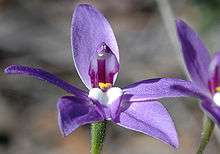Caladenia major
Caladenia major, commonly known as the waxlip orchid, parson-in-the-pulpit,[2] or purple cockatoo[3] is a plant in the orchid family Orchidaceae and is endemic to Australia. It is a ground orchid with a single hairy leaf and one or two purple to mauve flowers. It has been known as Glossodia major since its description by the prolific Scottish botanist Robert Brown in 1810, but recent discoveries suggest its inclusion in the genus Caladenia.
| Waxlip orchid | |
|---|---|
 | |
| Caladenia major growing in Tasmania | |
| Scientific classification | |
| Kingdom: | Plantae |
| Clade: | Tracheophytes |
| Clade: | Angiosperms |
| Clade: | Monocots |
| Order: | Asparagales |
| Family: | Orchidaceae |
| Subfamily: | Orchidoideae |
| Tribe: | Diurideae |
| Genus: | Caladenia |
| Species: | C. major |
| Binomial name | |
| Caladenia major | |
| Synonyms[1] | |
|
Glossodia major R.Br. | |
Description
Caladenia major is a terrestrial, perennial, deciduous, herb with an underground tuber. It has a single dark green, hairy, oblong to lance-shaped leaf, 30–60 mm (1–2 in) long and 15–20 mm (0.6–0.8 in) wide. One or two faintly fragrant flowers, 30–45 mm (1–2 in) long and wide are borne on a spike 80–350 mm (3–10 in) tall. The sepals and petals are purple to mauve except for their bases which are white with purple spots. Rarely, the flowers are all white. The dorsal sepal is 18–25 mm (0.7–1 in) long and 6–8 mm (0.2–0.3 in) wide. The lateral sepals are 18–25 mm (0.7–1 in) long and 7–10 mm (0.3–0.4 in) wide and spread apart from each other. The petals are 16–20 mm (0.6–0.8 in) long and 5–7 mm (0.2–0.3 in) wide and spread widely. The labellum is 7–10 mm (0.3–0.4 in) long, 5–7 mm (0.2–0.3 in) wide, white with a purple tip and with a furrow along its mid-line. At the base of the labellum there is a purple, cylinder-shaped appendage with two yellow, fleshy lobes on top. Flowering occurs from August to November.[2][3][4][5]
Taxonomy and naming
The waxlip orchid was first formally described in 1810 by Robert Brown who gave it the name Glossodia major and published the description in Prodromus Florae Novae Hollandiae.[6][7] In 2015, as a result of studies of molecular phylogenetics,[8] Mark Clements changed the name to Caladenia major.[1] The specific epithet (major) is a Latin word meaning "greater".[9]
Glossodia major is regarded as a synonym of the name Caladenia major which is accepted by the Royal Botanic Gardens, Kew.[10]
Distribution and habitat
Caladenia major occurs in all states of Australia except Western Australia and the Northern Territory. In New South Wales it is widespread and common in the eastern half of the state;[5] in Victoria it is also widespread and common in most areas with suitable habitat;[5] in South Australia it is common in the south-east, sometimes forming extensive colonies;[3] in Tasmania it is widespread and common[11] and in Queensland it grows in the south-east of that state.[12] This orchid is found in a range of habitats from coastal heath to woodland and dry open forest.
References
- "Caladenia major". APNI. Retrieved 14 April 2017.
- Jones, David L. (2006). A complete guide to native orchids of Australia including the island territories. Frenchs Forest, N.S.W.: New Holland. p. 33. ISBN 1877069124.
- "Glossodia major". State herbarium of South Australia; efloraSA. Retrieved 14 April 2017.
- Jeanes, Jeff. "Glossodia major". Royal Botanic Gardens, Victoria: VicFlora. Retrieved 14 April 2017.
- Bernhardt, Peter. "Glossodia major". Royal Botanic Gardens, Sydney: plantnet. Retrieved 14 April 2017.
- "Glossodia major". APNI. Retrieved 14 April 2017.
- Brown, Robert (1810). Prodromus florae Novae Hollandiae. London. p. 326. Retrieved 14 April 2017.
- Clements, Mark A.; Howard, Christopher G.; Miller, Joseph T. (13 April 2015). "Caladenia revisited: Results of molecular phylogenetic analyses of Caladeniinae plastid and nuclear loci". American Journal of Botany. 102 (4): 581–597. doi:10.3732/ajb.1500021. PMID 25878091.
- Brown, Roland Wilbur (1956). The Composition of Scientific Words. Washington, D.C.: Smithsonian Institution Press. p. 504.
- "Glossodia major". World Checklist of Selected Plant Families (WCSP). Royal Botanic Gardens, Kew.
- Jordan, Greg. "Glossodia major". Key to Tasmanian Vascular Plants. Retrieved 14 April 2017.
- "Glossodia major". Atlas of Living Australia. Retrieved 14 April 2017.